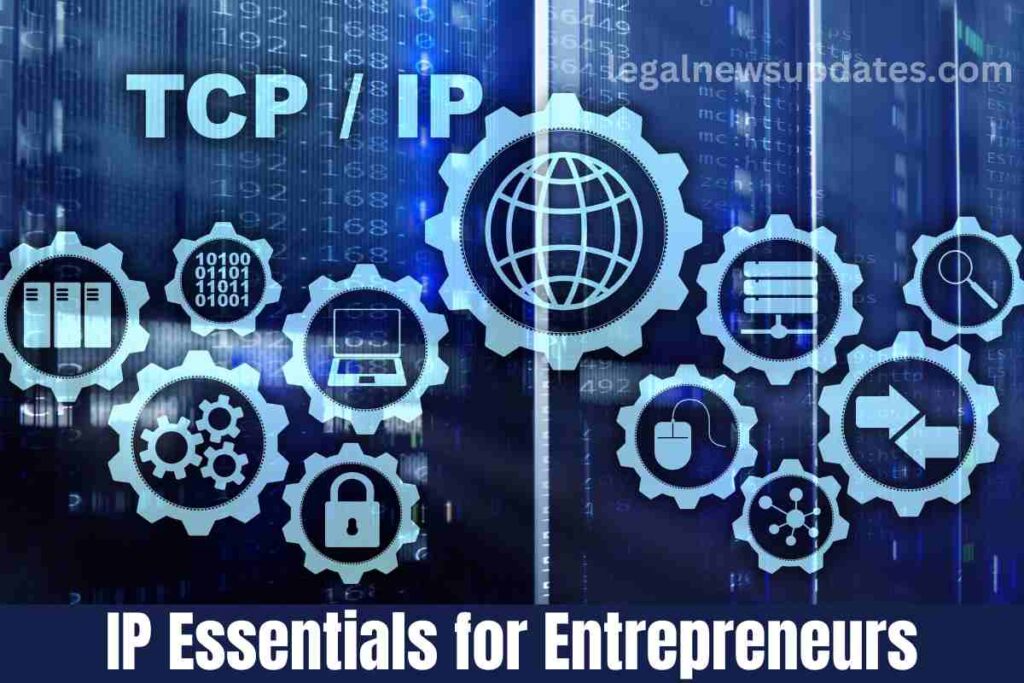IP Essentials for Entrepreneurs

Introduction: Unlocking Success: IP Essentials for Entrepreneurs
IP Essentials for Entrepreneurs is the bedrock upon which entrepreneurs build and scale their innovations. In a rapidly evolving market, safeguarding these assets is not just prudent; it’s necessary to maintain competitive advantage and foster long-term growth. This blog aims to demystify the concept of intellectual property for entrepreneurs, highlighting the importance of understanding, protecting, and leveraging IP in today’s business landscape.
IP rights offer legal protections for your creations, innovations, and distinct brand identifiers, preventing unauthorized use and allowing you to capitalize on your intellectual efforts. Whether it’s the unique design of a product, a breakthrough invention, an original written work, or a distinctive logo that sets your business apart, recognizing and securing these assets can be the difference between leading the market and fading into obscurity.
Understanding Intellectual Property: IP Essentials for Entrepreneurs
Intellectual property (IP) is a legal concept that grants creators and owners rights to their ideas and inventions, similar to how physical property laws allow for the ownership of physical assets. For entrepreneurs, understanding the different types of IP is the first step towards effectively managing and protecting these assets. IP can be broadly categorized into four main types: Patents, Trademarks, Copyrights, and Trade Secrets.
Patents provide inventors with exclusive rights to their inventions, preventing others from making, using, or selling the invention without permission for a certain period, typically 20 years. Patents are crucial for protecting groundbreaking technologies and innovations, giving inventors time to commercialize their creations. For example, the Wright brothers’ patent on their flying machine allowed them to maintain a competitive edge in the early days of aviation.
Trademarks protect symbols, names, and slogans used to identify goods or services. The primary purpose of a trademark is to prevent confusion in the marketplace, ensuring consumers can distinguish between different brands. A well-known trademark example is the Coca-Cola script, which is recognized globally and distinguishes it from other soft drink competitors.
Copyrights protect original works of authorship, including literature, music, and art, as well as software and databases. Copyright grants the creator exclusive rights to use, reproduce, and distribute their work. The copyright symbol © is a familiar sight, representing the legal recognition given to creators over their original content, like J.K. Rowling’s copyright over the Harry Potter series.
Trade Secrets consist of information unknown to the public and provide a business with a competitive advantage. Trade secrets can include formulas, practices, designs, instruments, or a compilation of information. The recipe for Coca-Cola is one of the most famous examples of a trade secret, closely guarded for over a century.
Why Protecting Your IP is Crucial
Protecting your intellectual property is not merely a legal formality; it’s a strategic business move that can define your brand’s value and longevity in the market. Here are some reasons why IP protection should be a priority for every entrepreneur:
Competitive Advantage: IP protection helps maintain your unique position in the market. Securing exclusive rights to your creations can prevent competitors from copying or closely imitating your products or services.
Business Value: IP assets can significantly increase the value of your business. They can attract investment, form the basis for strategic partnerships, and even become a significant revenue stream through licensing or sale.
Legal Protection: Securing your IP provides legal recourse in case of infringement. It empowers you to take action against competitors who attempt to profit from your creativity without authorization.
Without adequate protection, your business risks losing its unique assets to competitors, diluting your brand identity and eroding your market share. Failing to respect others’ IP rights can also lead to costly legal disputes that can jeopardize your business operations and reputation.
Step-by-Step Guide to Protecting IP
Protecting your intellectual property requires a strategic approach tailored to the type of IP and the specific needs of your business. Here’s a comprehensive guide to securing your intellectual assets:
Identifying Your IP Assets
Conduct an IP Audit: Identify all potential IP assets within your business. This includes inventions, product designs, brand names, logos, creative content, and trade secrets. An IP audit helps you understand what needs protection and prioritize based on commercial value and risk of infringement.
Securing IP: Detailed Process
Patents: If you have an invention or a unique process, consider applying for a patent. The process involves:
- Conducting a patent search to ensure your invention is new and not obvious.
- Preparing a detailed application, often with the help of a patent attorney, that describes the invention and claims the scope of protection.
- Filing the application with the relevant patent office and navigating through the examination process until approval.
Trademarks: To protect your brand identity, register your trademarks. The steps include:
- Performing a trademark search to ensure your mark is distinctive and not confusingly similar to existing marks.
- Applying for registration with the national or regional trademark office, specifying the goods or services the trademark will cover.
- Use the ™ symbol during the application process and the ® symbol once registered to signify your legal protection.
Copyrights: Copyright protection is automatic upon creation of original work, but registration can offer additional legal benefits. To register a copyright:
- Prepare copies of the work and a completed registration form.
- Submit these along with the registration fee to the copyright office.
- Use the copyright symbol © along with the year of first publication and the copyright owner’s name to notify the public of your rights.
Trade Secrets: Protection involves implementing internal safeguards:
- Identify confidential business information that provides a competitive edge.
- Develop a trade secret protection plan, including employee non-disclosure agreements, access controls, and security measures.
- Regularly review and update the protection measures to adapt to changes in the business environment.
Monitoring and Enforcing IP Rights
Stay Vigilant: Regularly monitor the market for potential infringements of your IP rights. This can involve watching for similar patents being filed, counterfeit products, or unauthorized use of your copyrighted material.
Take Action: If you discover infringement, consider all available remedies. This might involve sending a cease and desist letter, negotiating a settlement, or pursuing litigation. Legal action should be a last resort, considering its cost and complexity.
Common IP Mistakes Entrepreneurs Make: IP Essentials for Entrepreneurs
Even with a clear understanding of intellectual property, entrepreneurs can fall into traps that jeopardize their IP. Some common mistakes include:
Overlooking Non-Disclosure Agreements (NDAs): Please use NDAs when discussing your ideas or business operations to avoid leaks of valuable IP.
Failing to Register IP Promptly: Delaying the registration of patents, trademarks, or copyrights allows others to register similar IP first, complicating your ability to protect and enforce your rights.
Misunderstanding the Scope of IP Protection: Entrepreneurs sometimes assume that IP protection is broader than it is, leading to inadequate coverage for their assets.
Avoiding these mistakes is crucial for safeguarding the intellectual foundation of your business.
Leveraging IP for Business Growth
Intellectual property is not just a legal shield; it’s a strategic asset that can drive business expansion, innovation, and partnerships. Here’s how you can leverage IP for your business growth:
Licensing and Franchising: Licensing permits others to use your IP in exchange for royalties or fees. This can open new revenue streams without significant investment in production or marketing. On the other hand, franchising lets you expand your brand’s presence by allowing others to operate under your business model and brand name in exchange for fees and a share of the revenue.
IP as Collateral for Financing: IP assets can be valuable collateral for securing loans or attracting investors. Demonstrating that your business holds protected, revenue-generating IP can make it more appealing to financial institutions and venture capitalists.
Strategic Partnerships and Innovation: IP can be the foundation for strategic partnerships, joint ventures, or mergers and acquisitions. Sharing or co-developing IP with other businesses can lead to new products, services, and markets, driving mutual growth and innovation.
By actively managing and leveraging your IP, you can protect your business and position it for sustainable growth and competitiveness.
Global IP Protection Strategies
In today’s globalized economy, protecting your IP isn’t just a local concern; it’s a global necessity. Here are strategies to consider for international IP protection:
The Importance of Global IP Protection: As businesses expand into new markets, the risk of IP infringement increases. Protecting your IP globally ensures that your assets are safeguarded in every market you enter.
Navigating International IP Laws: IP laws vary significantly from country to country. Understanding these differences is crucial when planning to protect your IP internationally. It’s often advisable to work with legal experts in each jurisdiction to navigate the complexities of local IP laws.
Tips for Global IP Registration and Enforcement:
Prioritize Key Markets: Focus on securing IP protection in your primary and potential future markets.
Use International Treaties: Leverage international agreements, such as the Patent Cooperation Treaty (PCT) for patents and the Madrid System for trademarks, to streamline the application process across multiple countries.
Monitor and Enforce: Use international watch services to monitor for infringements globally, and be prepared to enforce your rights through local legal actions if necessary.
Protecting your IP globally requires careful planning and a proactive approach, but it is essential for businesses looking to thrive internationally.
Conclusion: IP Essentials for Entrepreneurs
For entrepreneurs, intellectual property is a crucial asset that demands careful management and protection. Understanding the types of IP, the importance of safeguarding them, and the strategies for leveraging IP assets are foundational elements for any successful business. Moreover, in an increasingly globalized market, extending that protection internationally is not just an option; it’s a necessity.
By prioritizing IP protection, entrepreneurs can secure their innovations, safeguard their competitive edge, and unlock new growth opportunities. Remember, intellectual property is not just a legal formality; it’s the heart of your business’s value proposition and a key driver of long-term success.
We’ve covered the essentials of protecting intellectual property for entrepreneurs, from understanding and securing IP rights to leveraging them for business growth and navigating the complexities of global protection. This comprehensive guide should serve as a starting point for entrepreneurs to appreciate the value of their IP assets and take proactive steps to protect and capitalize on them.










